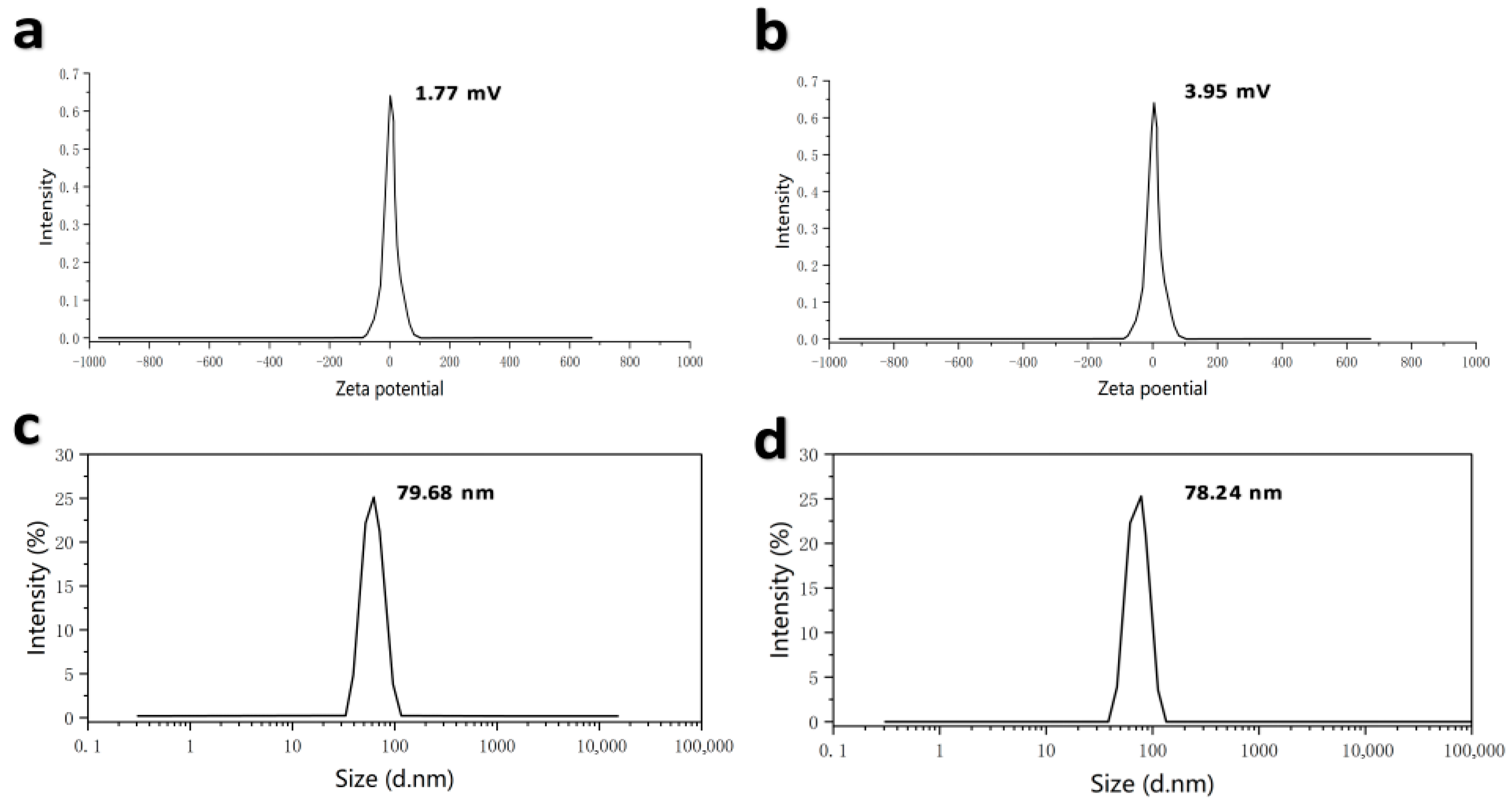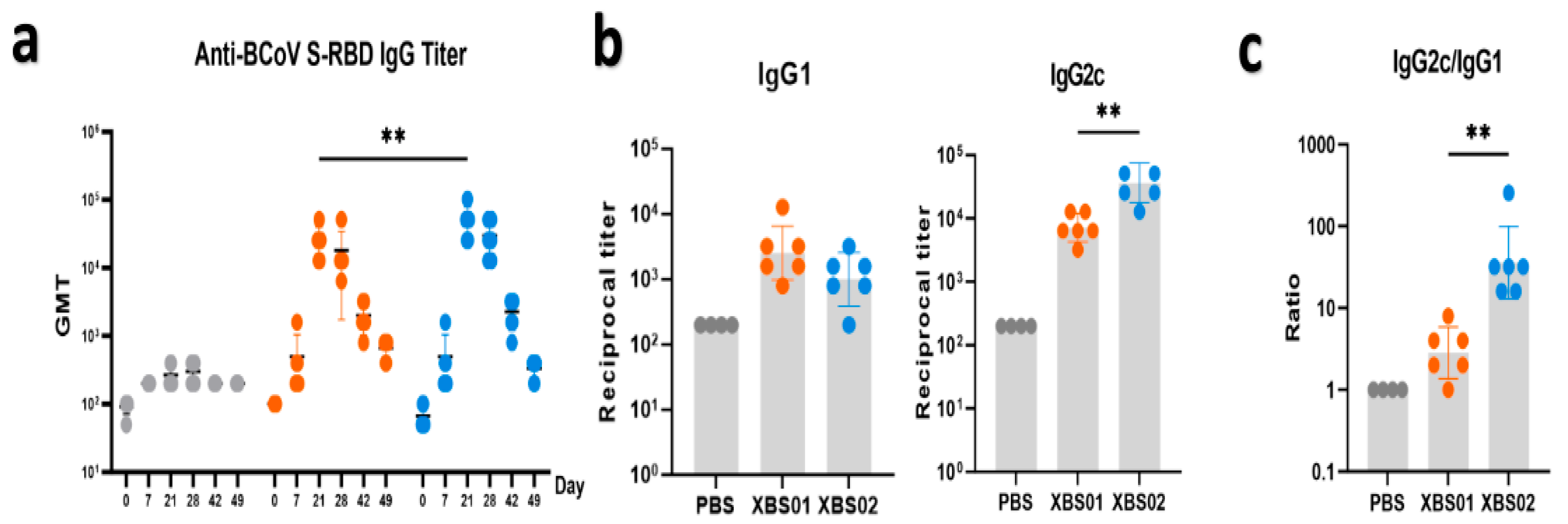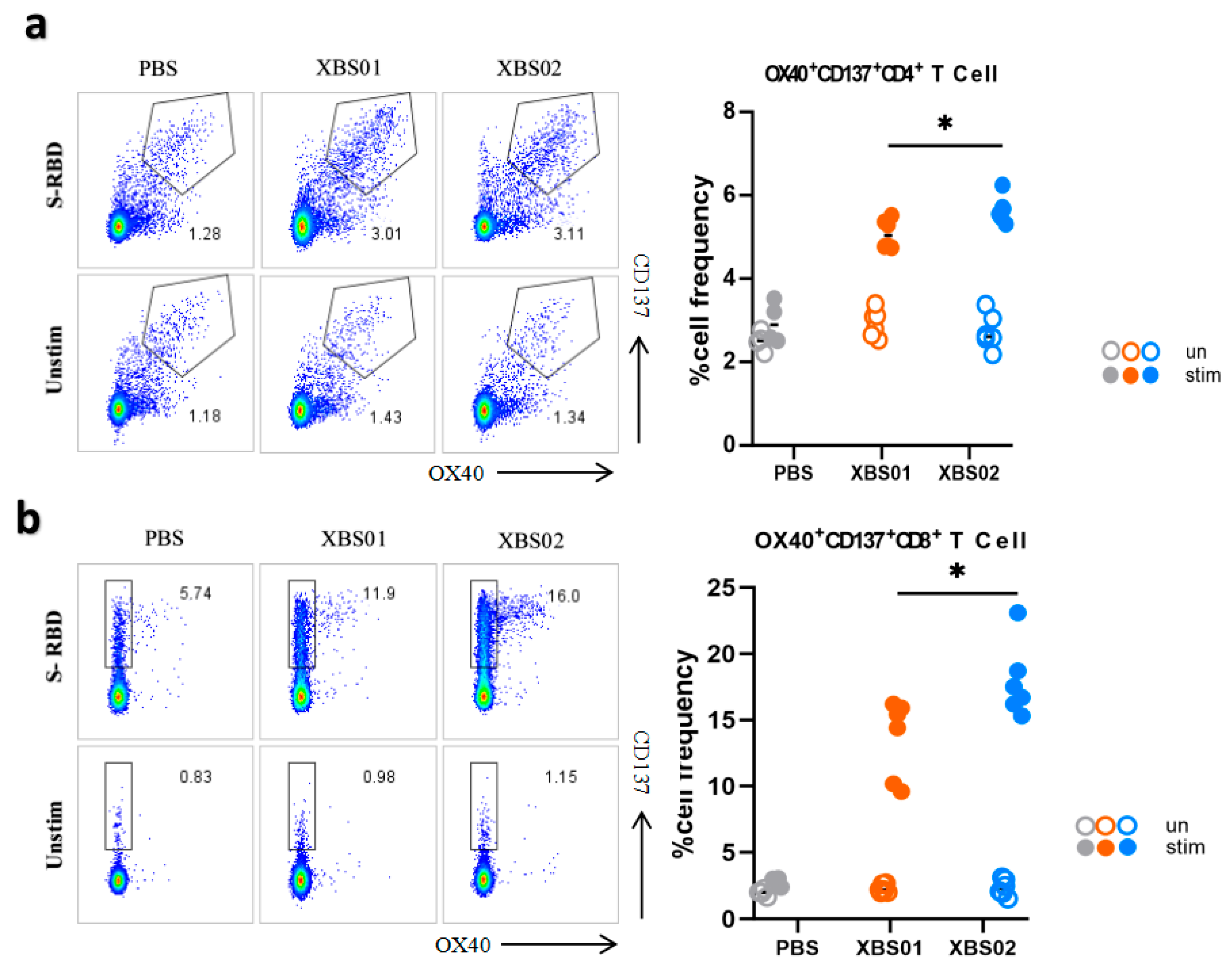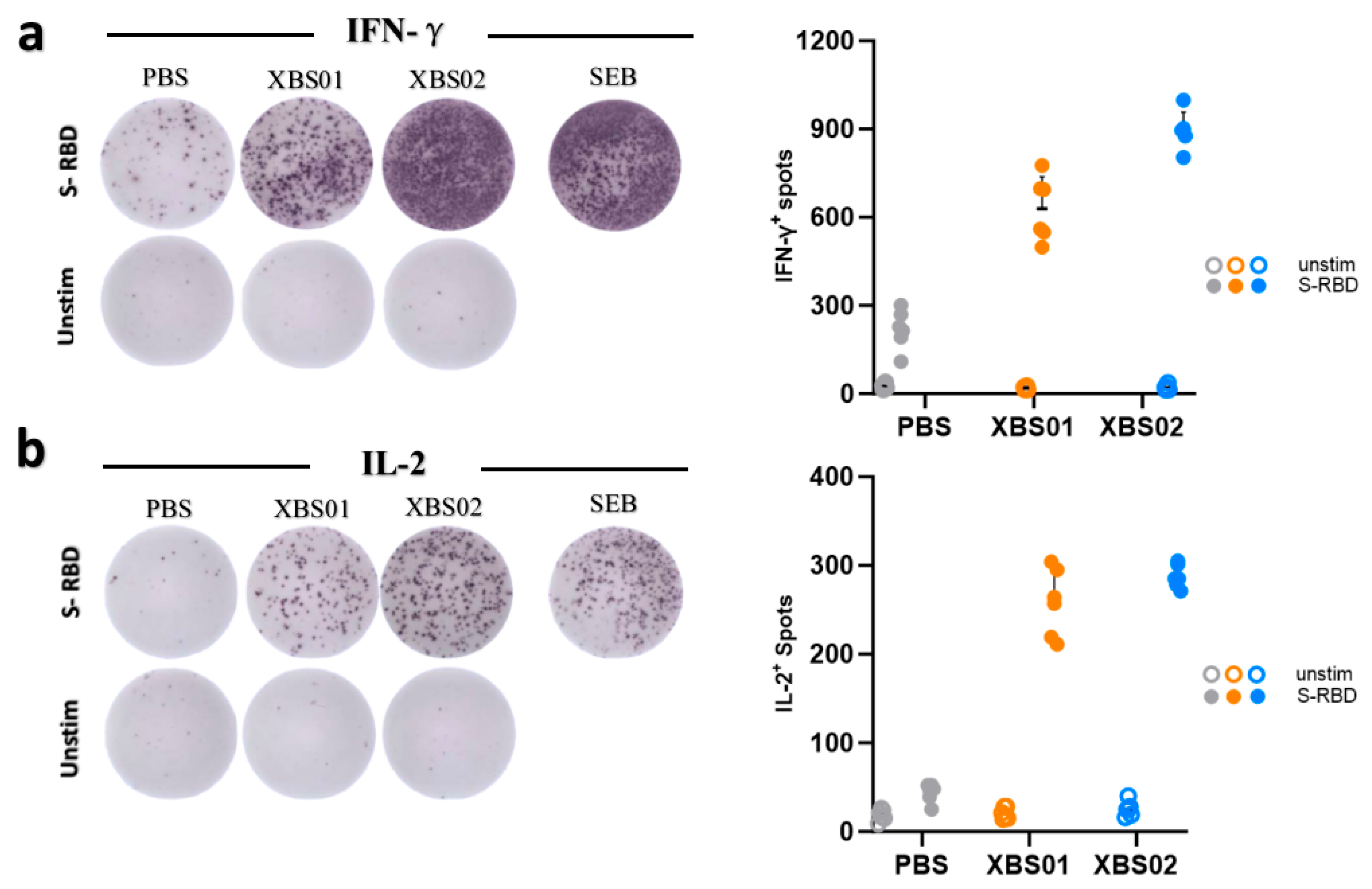Preparation and Immunological Efficacy Evaluation of mRNA Vaccines Targeting the Spike Protein of Bovine Coronavirus
Abstract
1. Introduction
2. Materials and Methods
2.1. Main Reagents
2.2. Experimental Animals
2.3. mRNA Vaccine Preparation
2.4. Immunization Protocol
2.5. Indicators and Methods for Immunological Efficacy Detection
2.5.1. ELISA Antibody Detection
2.5.2. Memory B Cell Response Analysis
2.5.3. Antigen-Specific T Cell Detection
2.5.4. Enzyme-Linked Immunospot (ELISpot) Detection
3. Results
3.1. Design and Characterization of BCoV mRNA Vaccines (XBS01 and XBS02)
3.2. Induction of BCoV S-RBD-Specific Antibodies by Vaccines in Mice
3.3. Induction of Specific S-RBD Memory B Cell Responses by Vaccines in Mice
3.4. Induction of S-RBD-Specific T Cell Responses by Vaccines in Mice
3.5. Enhanced Cytokine Secretion by Mouse Splenocytes Induced by Vaccines
4. Discussion
5. Conclusions
Supplementary Materials
Author Contributions
Funding
Institutional Review Board Statement
Informed Consent Statement
Data Availability Statement
Acknowledgments
Conflicts of Interest
References
- Liu, Q.; Niu, X.; Fang, M.; Liu, Y.; Gao, H.; Chen, J.; Zhang, S.; Li, Y. Research progress of Bovine coronavirus spike protein. Acta Vet. Zootech. Sin. 2024, 55, 944–956. (In Chinese) [Google Scholar]
- Zhu, Q.; Li, B.; Sun, D. Advances in Bovine coronavirus epidemiology. Viruses 2022, 14, 1109. [Google Scholar] [CrossRef] [PubMed]
- Parkhe, P.; Verma, S. Evolution, interspecies transmission, and zoonotic significance of animal Coronaviruses. Front. Vet. Sci. 2021, 8, 719834. [Google Scholar] [CrossRef] [PubMed]
- Saif, L.J.; Jung, K. Comparative pathogenesis of bovine and porcine respiratory Coronaviruses in the animal host species and SARS-CoV-2 in humans. J. Clin. Microbiol. 2020, 58, e01355-20. [Google Scholar] [CrossRef]
- Tian, M. Discussion on the etiology and prevention progress of bovine respiratory diseases. China Anim. Ind. 2019, 15, 147. (In Chinese) [Google Scholar]
- Armstrong, J.; Niemann, H.; Smeekens, S.; Rottier, P.; Warren, G. Sequence and topology of a model intracellular membrane protein, E1 glycoprotein, from a coronavirus. Nature 1984, 308, 751–752. [Google Scholar] [CrossRef]
- Vlasova, A.N.; Saif, L.J. Bovine coronavirus and the associated diseases. Front. Vet. Sci. 2021, 8, 643220. [Google Scholar] [CrossRef]
- Redda, Y.T.; Adamu, H.; Bergholm, J.; Lindahl, J.F.; Blomström, A.-L.; Berg, M.; Tessema, T.S. Detection and characterization of bovine coronavirus and rotavirus in calves in Ethiopia. BMC Vet. Res. 2025, 21, 122. [Google Scholar] [CrossRef]
- Shen, S.S.; Chen, L.; Feng, W.Y.; Lan, S.J.; Li, D.; Miao, Y.; Zhang, L.; Huang, B.Y.; Wang, H.; Liu, W.; et al. Research Progress on Bovine Coronavirus. Prog. Vet. Med. 2022, 43, 112–116. [Google Scholar]
- Li, F. Structure, function, and evolution of coronavirus spike proteins. Annu. Rev. Virol. 2016, 3, 1954–1964. [Google Scholar] [CrossRef]
- Wang, Y.; Grunewald, M.; Perlman, S. Coronaviruses: An Updated Overview of Their Replication and Pathogenesis. Methods Mol. Biol. 2020, 2203, 21–29. [Google Scholar] [CrossRef]
- Gallagher, T.M.; Buchmeier, M.J. Coronavirus spike proteins in viral entry and pathogenesis. Virology 2001, 279, 371–374. [Google Scholar] [CrossRef]
- Yoo, D.W.; Parker, M.D.; Babiuk, L.A. The S2 subunit of the spike glycoprotein of bovine coronavirus mediates membrane fusion in insect cells. Virology 1991, 180, 395–399. [Google Scholar] [CrossRef]
- Jung, J.; Bong, J.-H.; Kim, T.-H.; Sung, J.S.; Lee, C.; Kang, M.-J.; Kim, H.O.; Shin, H.-J.; Pyun, J.-C. Isolation of antibodies against the spike protein of SARS-CoV from pig serum for competitive immunoassay. BioChip J. 2021, 15, 396–405. [Google Scholar] [CrossRef]
- Muralidar, S.; Gopal, G.; Ambi, S.V. Targeting the viral-entry facilitators of SARS-CoV-2 as a therapeutic strategy in COVID-19. J. Med. Virol. 2021, 93, 5260–5276. [Google Scholar] [CrossRef]
- Workman, A.M.; McDaneld, T.G.; Harhay, G.P.; Das, S.; Loy, J.D.; Hause, B.M. Recent emergence of bovine coronavirus variants with mutations in the hemagglutinin-esterase receptor binding domain in U.S. cattle. Viruses 2022, 14, 2125. [Google Scholar] [CrossRef]
- Pan, J.H.; Mao, M.X.; Zhou, K.Y.T.; Liu, R.H.; Wang, S.C.; Wei, S.M.; Qi, Q.; Wang, K.C. Current status and research progress of animal infection with severe acute respiratory syndrome coronavirus 2 (SARS-CoV-2). J. Nanjing Agric. Univ. 2025, 48, 274–284. [Google Scholar]
- Corey, L.; Miner, M.D. Accelerating clinical trial development in vaccinology: COVID-19 and beyond. Curr. Opin. Immunol. 2022, 76, 102206. [Google Scholar] [CrossRef] [PubMed]
- Foster, J.B.; Choudhari, N.; Perazzelli, J.; Storm, J.; Hofmann, T.J.; Jain, P.; Storm, P.B.; Pardi, N.; Weissman, D.; Waanders, A.J.; et al. Purification of mRNA encoding chimeric antigen receptor is critical for generation of a robust T-cell response. Hum. Gene Ther. 2019, 30, 168–178. [Google Scholar] [CrossRef] [PubMed]
- Tsakiri, M.; Naziris, N.; Demetzos, C. Innovative vaccine platforms against infectious diseases: Under the scope of the COVID-19 pandemic. Int. J. Pharm. 2021, 610, 121212. [Google Scholar] [CrossRef]
- Pardi, N.; Hogan, M.J.; Porter, F.W.; Weissman, D. mRNA vaccines—A new era in vaccinology. Nat. Rev. Drug Discov. 2018, 17, 261–279. [Google Scholar] [CrossRef]
- Alameh, M.-G.; Weissman, D.; Pardi, N. Messenger RNA-based vaccines against infectious diseases. Curr. Top. Microbiol. Immunol. 2020, 440, 111–145. [Google Scholar] [CrossRef]
- Pardi, N.; Hogan, M.J.; Naradikian, M.S.; Parkhouse, K.; Cain, D.W.; Jones, L.; Moody, M.A.; Verkerke, H.P.; Myles, A.; Willis, E.; et al. Nucleoside-modified mRNA vaccines induce potent T follicular helper and germinal center B cell responses. J. Exp. Med. 2018, 215, 1571–1588. [Google Scholar] [CrossRef]
- Amoroso, M.G.; Lucifora, G.; Degli Uberti, B.; Serra, F.; De Luca, G.; Borriello, G.; De Domenico, A.; Brandi, S.; Cuomo, M.C.; Bove, F.; et al. Fatal interstitial pneumonia associated with bovine coronavirus in cows from southern Italy. Viruses 2020, 12, 1331. [Google Scholar] [CrossRef]
- Mekata, H.; Hamabe, S.; Sudaryatma, P.E.; Kobayashi, I.; Kanno, T.; Okabayashi, T. Molecular epidemiological survey and phylogenetic analysis of bovine respiratory coronavirus in Japan from 2016 to 2018. J. Vet. Med. Sci. 2020, 82, 726–730. [Google Scholar] [CrossRef] [PubMed]
- Shin, J.; Choe, S.; Park, G.-N.; Song, S.; Kim, K.-S.; An, B.-H.; Hyun, B.-H.; An, D.-J. Isolation and genetic characterization of a bovine coronavirus KBR-1 strain from calf feces in south Korea. Viruses 2022, 14, 2376. [Google Scholar] [CrossRef] [PubMed]
- Geng, H.L.; Meng, X.Z.; Yan, W.L.; Li, X.M.; Jiang, J.; Ni, H.B.; Liu, W.H. Prevalence of bovine coronavirus in cattle in China: A systematic review and meta-analysis. Microb. Pathog. 2023, 176, 106009. [Google Scholar] [CrossRef]
- Lin, Y.; Shen, X.; Yang, R.F.; Li, Y.X.; Ji, Y.Y.; He, Y.Y.; De Shi, M.; Lu, W.; Shi, T.L.; Wang, J.; et al. Identification of an epitope of SARS-coronavirus nucleocapsid protein. Cell Res. 2003, 13, 141–145. [Google Scholar] [CrossRef]
- Wrapp, D.; Wang, N.; Corbett, K.S.; Goldsmith, J.A.; Hsieh, C.-L.; Abiona, O.; Graham, B.S.; McLellan, J.S. Cryo-EM structure of the 2019-nCoV spike in the prefusion conformation. Science 2020, 367, 1260–1263. [Google Scholar] [CrossRef] [PubMed]
- Ochsenbein, A.F.; Sierro, S.; Odermatt, B.; Pericin, M.; Karrer, U.; Hermans, J.; Hemmi, S.; Hengartner, H.; Zinkernagel, R.M. Roles of tumour localization, second signals and cross priming in cytotoxic T-cell induction. Nature 2001, 411, 1058–1064. [Google Scholar] [CrossRef]
- Connors, J.; Joyner, D.; Mege, N.J.; Cusimano, G.M.; Bell, M.R.; Marcy, J.; Taramangalam, B.; Kim, K.M.; Lin, P.J.C.; Tam, Y.K.; et al. Lipid nanoparticles (LNP) induce activation and maturation of antigen presenting cells in young and aged individuals. Commun. Biol. 2023, 6, 188. [Google Scholar] [CrossRef]
- Alameh, M.-G.; Tombácz, I.; Bettini, E.; Lederer, K.; Sittplangkoon, C.; Wilmore, J.R.; Gaudette, B.T.; Soliman, O.Y.; Pine, M.; Hicks, P.; et al. Lipid nanoparticles enhance the efficacy of mRNA and protein subunit vaccines by inducing robust T follicular helper cell and humoral responses. Immunity 2021, 54, 2877–2892.e7. [Google Scholar] [CrossRef]
- Pérez-Pérez, L.; Laidlaw, B.J. Polarization of the memory B-cell response. J. Leukoc. Biol. 2025, 117, qiae228. [Google Scholar] [CrossRef]
- Verbeke, R.; Hogan, M.J.; Loré, K.; Pardi, N. Innate immune mechanisms of mRNA vaccines. Immunity 2022, 55, 1993–2005. [Google Scholar] [CrossRef]
- Chaudhary, N.; Weissman, D.; Whitehead, K.A. mRNA vaccines for infectious diseases: Principles, delivery and clinical translation. Nat. Rev. Drug Discov. 2021, 20, 817–838. [Google Scholar] [CrossRef]
- Sad, S.; Mosmann, T.R. Single IL-2-secreting precursor CD4 T cell can develop into either Th1 or Th2 cytokine secretion phenotype. J. Immunol. 1994, 153, 3514–3522. [Google Scholar] [CrossRef] [PubMed]
- Bendelac, A.; Killeen, N.; Littman, D.R.; Schwartz, R.H.; Littman, D.R. A subset of CD4+ thymocytes selected by MHC class I molecules. Science 1994, 263, 1774–1778. [Google Scholar] [CrossRef] [PubMed]
- Kao, D.; Lux, A.; Schaffert, A.; Lang, R.; Altmann, F.; Nimmerjahn, F. IgG subclass and vaccination stimulus determine changes in antigen specific antibody glycosylation in mice. Eur. J. Immunol. 2017, 47, 2070–2079. [Google Scholar] [CrossRef] [PubMed]
- Macian, F. NFAT proteins: Key regulators of T-cell development and function. Nat. Rev. Immunol. 2005, 5, 472–484. [Google Scholar] [CrossRef] [PubMed]
- Zhu, Y.; Saribas, A.S.; Liu, J.; Lin, Y.; Bodnar, B.; Zhao, R.; Guo, Q.; Ting, J.; Wei, Z.; Ellis, A.; et al. Protein expression/secretion boost by a novel unique 21-mer cis-regulatory motif (Exin21) via mRNA stabilization. Mol. Ther. 2023, 31, 1136–1157. [Google Scholar] [CrossRef]
- Bazzini, A.A.; Del Viso, F.; Moreno-Mateos, M.A.; Johnstone, T.G.; Vejnar, C.E.; Qin, Y.; Yao, J.; Khokha, M.K.; Giraldez, A.J. Codon identity regulates mRNA stability and translation efficiency during the maternal-to-zygotic transition. EMBO J. 2016, 35, 2087–2103. [Google Scholar] [CrossRef]
- Bae, H.; Coller, J. Codon optimality-mediated mRNA degradation: Linking translational elongation to mRNA stability. Mol. Cell 2022, 82, 1467–1476. [Google Scholar] [CrossRef]
- Novoa, E.M.; Jungreis, I.; Jaillon, O.; Kellis, M. Elucidation of codon usage signatures across the domains of life. Mol. Biol. Evol. 2019, 36, 2328–2339. [Google Scholar] [CrossRef]
- Presnyak, V.; Alhusaini, N.; Chen, Y.-H.; Martin, S.; Morris, N.; Kline, N.; Olson, S.; Weinberg, D.; Baker, K.E.; Graveley, B.R.; et al. Codon optimality is a major determinant of mRNA stability. Cell 2015, 160, 1111–1124. [Google Scholar] [CrossRef] [PubMed]
- Kaur, S.; Bansal, Y.; Kumar, R.; Bansal, G. A panoramic review of IL-6: Structure, pathophysiological roles and inhibitors. Bioorganic Med. Chem. 2020, 28, 115327. [Google Scholar] [CrossRef] [PubMed]
- Knorr, A.G.; Mackens-Kiani, T.; Musial, J.; Berninghausen, O.; Becker, T.; Beatrix, B.; Beckmann, R. The dynamic architecture of Map1- and NatB-ribosome complexes coordinates the sequential modifications of nascent polypeptide chains. PLoS Biol. 2023, 21, e3001995. [Google Scholar] [CrossRef] [PubMed]
- Zhang, X.; Rashid, R.; Wang, K.; Shan, S.-O. Sequential checkpoints govern substrate selection during cotranslational protein targeting. Science 2010, 328, 757–760. [Google Scholar] [CrossRef]
- Voorhees, R.M.; Hegde, R.S. Structures of the scanning and engaged states of the mammalian SRP-ribosome complex. eLife 2015, 4, e07975. [Google Scholar] [CrossRef] [PubMed]
- Zhang, Y.; Zhai, S.; Huang, H.; Qin, S.; Sun, M.; Chen, Y.; Lan, X.; Li, G.; Huang, Z.; Wang, D.; et al. Efficient signal sequence of mRNA vaccines enhances the antigen expression to expand the immune protection against viral infection. J. Nanobiotechnol. 2024, 22, 295. [Google Scholar] [CrossRef]
- Yang, J.; Wang, W.; Chen, Z.; Lu, S.; Yang, F.; Bi, Z.; Bao, L.; Mo, F.; Li, X.; Huang, Y.; et al. A vaccine targeting the RBD of the S protein of SARS-CoV-2 induces protective immunity. Nature 2020, 586, 572–577. [Google Scholar] [CrossRef]






Disclaimer/Publisher’s Note: The statements, opinions and data contained in all publications are solely those of the individual author(s) and contributor(s) and not of MDPI and/or the editor(s). MDPI and/or the editor(s) disclaim responsibility for any injury to people or property resulting from any ideas, methods, instructions or products referred to in the content. |
© 2025 by the authors. Licensee MDPI, Basel, Switzerland. This article is an open access article distributed under the terms and conditions of the Creative Commons Attribution (CC BY) license (https://creativecommons.org/licenses/by/4.0/).
Share and Cite
Liu, S.; Gong, Z.; Wang, P.; Chen, F.; Fu, X.; Fan, H.; Li, Y.; Han, X.; Chen, J.; Zhang, L.; et al. Preparation and Immunological Efficacy Evaluation of mRNA Vaccines Targeting the Spike Protein of Bovine Coronavirus. Vaccines 2025, 13, 1155. https://doi.org/10.3390/vaccines13111155
Liu S, Gong Z, Wang P, Chen F, Fu X, Fan H, Li Y, Han X, Chen J, Zhang L, et al. Preparation and Immunological Efficacy Evaluation of mRNA Vaccines Targeting the Spike Protein of Bovine Coronavirus. Vaccines. 2025; 13(11):1155. https://doi.org/10.3390/vaccines13111155
Chicago/Turabian StyleLiu, Shuyue, Zhen Gong, Ping Wang, Fu Chen, Xiulong Fu, Haoyu Fan, Yue Li, Xiangshu Han, Junli Chen, Lixue Zhang, and et al. 2025. "Preparation and Immunological Efficacy Evaluation of mRNA Vaccines Targeting the Spike Protein of Bovine Coronavirus" Vaccines 13, no. 11: 1155. https://doi.org/10.3390/vaccines13111155
APA StyleLiu, S., Gong, Z., Wang, P., Chen, F., Fu, X., Fan, H., Li, Y., Han, X., Chen, J., Zhang, L., Xue, L., Bai, H., Liu, S., Huang, L., Du, W., Lin, A., & Xia, J. (2025). Preparation and Immunological Efficacy Evaluation of mRNA Vaccines Targeting the Spike Protein of Bovine Coronavirus. Vaccines, 13(11), 1155. https://doi.org/10.3390/vaccines13111155







